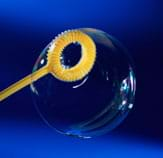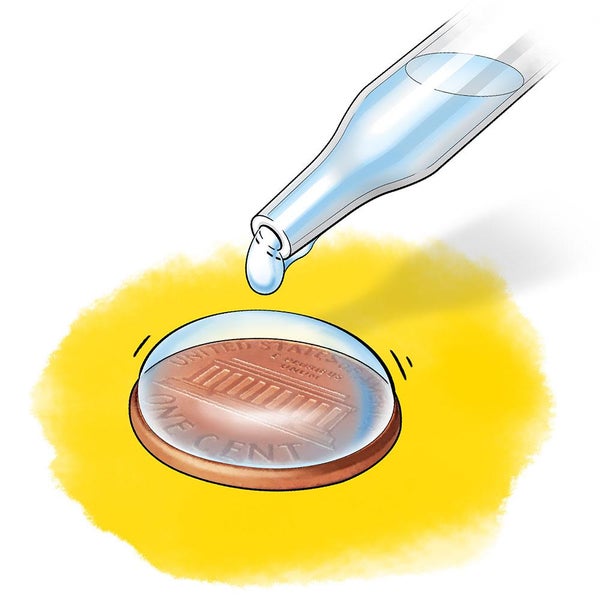FREE K-12 standards-aligned STEM
curriculum for educators everywhere!
Find more at TeachEngineering.org .
- TeachEngineering
- Surface Tension Lab

Hands-on Activity Surface Tension Lab
Grade Level: 12 (10-12)
Time Required: 45 minutes
Expendable Cost/Group: US $4.50
Group Size: 3
Activity Dependency: Surface Tension Basics
Subject Areas: Chemistry, Physical Science, Physics
NGSS Performance Expectations:

Curriculum in this Unit Units serve as guides to a particular content or subject area. Nested under units are lessons (in purple) and hands-on activities (in blue). Note that not all lessons and activities will exist under a unit, and instead may exist as "standalone" curriculum.
- Exploring Capillary Action
- Measuring Surface Tension
- Investigating Contact Angle
- Exploring the Lotus Effect
TE Newsletter
Engineering connection, learning objectives, materials list, worksheets and attachments, more curriculum like this, introduction/motivation, troubleshooting tips, activity extensions, user comments & tips.

Engineers design inkjet printers by exploiting the tendency of a continuous stream of water to break apart and form droplets. Surface tension must be finely adjusted, both for the ink to form droplets of the desired size and for the ink to adhere to the paper surface without smearing or bleeding, so part of the chemical engineering includes the "ink" formulation. Inkjet printers are also especially designed for many industrial applications, such as automotive coatings, decoration of curved and irregularly-shaped surfaces, printing conductive patterns with metallic particles, replacing screen printing on everything from ceramics to textiles, and creating rapid 3D prototypes.
After this activity, students should be able to:
- Describe the procedure developed to test the bubble mixtures, and explain how the procedure could be improved.
- Describe the criteria used to determine whether a solution created a "better" bubble, and explain how the criteria could be improved.
Educational Standards Each TeachEngineering lesson or activity is correlated to one or more K-12 science, technology, engineering or math (STEM) educational standards. All 100,000+ K-12 STEM standards covered in TeachEngineering are collected, maintained and packaged by the Achievement Standards Network (ASN) , a project of D2L (www.achievementstandards.org). In the ASN, standards are hierarchically structured: first by source; e.g. , by state; within source by type; e.g. , science or mathematics; within type by subtype, then by grade, etc .
Ngss: next generation science standards - science, common core state standards - math.
View aligned curriculum
Do you agree with this alignment? Thanks for your feedback!

International Technology and Engineering Educators Association - Technology
State standards, north carolina - math, north carolina - science.
Each group needs:

- liquid soap (variation idea: give different brands to different groups for students to compare)
- bubble wand (available at discount, toy and dollar stores)
- measuring cups
- safety goggles or glasses for eye protection
- Bubble Surface Tension Lab Handout , one per person
- Why Do Liquid Jets Form Droplets? (homework), one per person
(Begin with the associated lesson , and its Introduction/Motivation talk, to set the stage for conducting this activity with students. The lesson provides photos, short videos and background information on surface tension, adhesive forces and engineering applications.)
What do we know about surface tension? What have we observed by closely examining falling water (such as from a faucet or hose)? (Listen to student answers; recap with points below, as necessary):
- Water in a stream or jet starts out in a cylindrical column, and ends up as droplets. This also happens to ink ejected from the nozzles of inkjet printers.
- Water molecules really like to stick together and that causes water to act the way it does. Intermolecular (cohesive) forces cause liquid molecules to be attracted to each other and they pull liquid molecules towards each other. At the liquid/air interface, without these forces from the air side, the outer layer of the liquid acts like a stretched membrane and moves to minimize the surface energy, creating what we call surface tension.
- So at the surface, the liquid molecules move to create the least surface area possible, as a way to minimize the stretching of the skin, and lower the amount of energy in tension on the surface. And so falling water (and the sprayed ink in inkjet printers) forms into spheres.
- The water forms into round drops (not cubes or any other shape) because spheres are the shape with the least amount of surface area for a given volume of liquid.
- Mixing soap (a surface-active agent or surfactant) with water lowers surface tension, and that's how we can create soap bubbles. With a lower surface tension, the air/liquid surface is more "stretchy." By contrast, high surface tensions encourage liquids to bead rather than spread evenly across surfaces.
- (Continue by asking the pre-activity discussion questions, as provided in the Assessment section.)
Have you ever tried to make your own soap bubble solution? How well did it work? (Usually, some students have done this. Let them describe whether or not the solutions worked, and how well they worked.) Getting the surface tension just right to make a really good soap bubble can be tricky. Today we are going to try to figure out the perfect recipe for making soap bubbles.
Droplets form due to the surface tension of the liquid—a larger surface area requires more energy to maintain due to the molecular forces associated with surface tension. When water transitions from a column into droplets, the same volume of water requires a smaller surface area and therefore requires less energy. These are suggested procedures, which you may need to alter, depending on student level, time constraints, and material availability.
Before the Activity
- Gather materials and organize lab stations.
- Make copies of Bubble Surface Tension Lab Handout and Why Do Liquid Jets Form Droplets? math homework.
With the Students
- Divide the class into lab groups, and send them to lab stations.
- Have students use the lab handout to conduct all four parts of the lab, answering questions as they go.
- Part 1: What makes a good soap bubble? Students decide how to measure whether a soap bubble is "good" or not. For example, they might measure how large the bubble is, how long it lasts, or how far it floats once it leaves the wand.
- Part 2: Soap and Water Bubbles: Students describe procedures for testing mixtures of soap (surfactant) and water for their bubble-making abilities, record their results, and indicate which mixture performed best.
- Part 3: Additional Additives: Students refine their recipes by adding a third additive to the best mixture from Part 2, in varying amounts, to improve their solutions.
- Part 4: Analysis and Reflection: Students describe their best soap bubble recipes and assess how their measurements and procedures could be improved.
- Conclude with team-to-team presentations and discussions of lab techniques, procedures and results, and have students create summary documents. This post-activity assessment is described in the Assessment section.
- Assign the math homework, as described in the Assessment section.
Pre-Activity Assessment
Discussion Questions: Ask the students and discuss as a class:
- How do water bugs walk on the surface of the water? (Answer: They are light enough that they do not overcome the attraction of the molecules on the surface of the water.)
- Why do soap bubbles form spheres instead of cubes? (Students will learn the answer to this question during the activity. Answer: The soap bubble acts like a rubber band and takes on the smallest shape it can with the air still trapped inside.)
- What happens when a soap bubble pops? (Answer: The air is no longer trapped inside and the soap surface acts like a snapped rubber band and quickly contracts.)
- Why do you need soap to create a soap bubble? (Answer: The soap lowers the surface tension and makes the surface more "stretchy.")
Activity Embedded Assessment
Activity Questions: In this activity, students extend their understanding of surface tension to the real-world engineering problem of deciding what makes a "good" soap bubble and how to measure this property; they use this measurement to determine the best soap solution for creating bubbles. By answering the questions on the Bubble Surface Tension Lab Handout , students demonstrate their thought processes. Gauge student comprehension by circulating throughout the classroom, asking students how they answered different questions.
Post-Activity Assessment
Present to Others: After all groups are finished, or during the following class period, assign students from different lab groups to different "discussion" groups. Within each group, direct the members to describe their measurement techniques, procedures and results. Have each discussion group create a document that:
- Summarizes the measurement techniques used and the strengths and weaknesses of each.
- Describes an example procedure that includes lessons learned from performing the experiment.
- Summarizes the results found by each member of the discussion group.
- Uses the combined results to suggest further experiments to improve the bubble solution.
Why Does a Liquid Jet Form Droplets? In this homework assignment (see attachment ), students calculate the surface area for the same volume taking three different shapes. They see that the shape that creates the least amount of surface area is spherical drops. Note to teacher: Although not discussed in the homework, the liquid droplets must have a certain minimum radius before they are preferable to the cylindrical column in terms of surface area. If the liquid broke up into water droplets with radii smaller than the radius of the cylinder, for example, that would actually increase the surface area of the water. The larger the radius of a liquid jet, then the larger droplets the jet forms in order to decrease surface area.
Safety Issues
- Use eye protection during this activity.
Be aware of the two most common problems in this lab, which students may discover on their own and include in their own assessment of their procedures:
- Not thoroughly rinsing cups before reusing
- Not rinsing bubble wands between uses
Have teams test and compare different brands of liquid soap.
If this activity is used in a physics class, modify the soap bubble portion to include the diffraction of light and the colors of the soap bubble. These colors depend on the thickness of the soap film. This is similar to the colors produced by a thin film of oil on water.

Students are presented with the question: "Why does a liquid jet break up into droplets?" and introduced to its importance in inkjet printers. A discussion of cohesive forces and surface tension is included, as well as surface acting agents (surfactants) and their ability to weaken the surface tensi...

Student teams are challenged to evaluate the design of several liquid soaps to answer the question, “Which soap is the best?” Through two simple teacher class demonstrations and the activity investigation, students learn about surface tension and how it is measured, the properties of surfactants (so...

Students learn about the basics of molecules and how they interact with each other. They learn about the idea of polar and non-polar molecules and how they act with other fluids and surfaces. Students acquire a conceptual understanding of surfactant molecules and how they work on a molecular level. ...

Students are presented with a short lesson on the difference between cohesive forces (the forces that hold water molecules together and create surface tension) and adhesive forces (the forces that causes water to "stick" to solid surfaces. Students are also introduced to examples of capillary action...

Contributors
Supporting program, acknowledgements.
This digital library content was developed under an NSF CAREER Award (CBET- 08-46705) and an RET supplement (CBET-10-09869). However, these contents do not necessarily represent the policies of the National Science Foundation, and you should not assume endorsement by the federal government.
Last modified: May 17, 2019
June 25, 2015
Measure Surface Tension with a Penny
A soapy science activity from Science Buddies
By Science Buddies

Learn about the secrets of soap in this surprising surface tension-testing activity!
George Retseck
Key concepts Chemistry Molecules Surface tension
Introduction Have you ever noticed on a rainy day how water forms droplets on a window? Why does it do that instead of spreading out evenly over the whole surface? You might not guess it but this property of water is also related to washing dishes and doing the laundry. How? It all has to do with something called surface tension. Try this activity to learn more!
Background You have probably noticed that if you look at a surface outside on a rainy day or spill some water inside, the liquid tends to form droplets that stick up from a surface instead of spreading out into an even sheet. This occurs because water is made up of many tiny molecules that are all attracted to one another. Molecules in the middle of a drop of water are pulled evenly in all directions by all the nearby molecules. Those near the droplet’s surface, however, are pulled mostly inward by the water molecules below them. This creates "surface tension." The surface of the water droplet is held together by the attraction between molecules.
On supporting science journalism
If you're enjoying this article, consider supporting our award-winning journalism by subscribing . By purchasing a subscription you are helping to ensure the future of impactful stories about the discoveries and ideas shaping our world today.
Now, think about washing dirty dishes or clothing. There will be lots of tiny little holes and cracks that water needs to get into to wash away dirt and grime, such as the spaces between the fibers of a shirt or between a plate and bits of dried food. In order for water to flow more easily into these small spaces, you need to decrease its surface tension. You can do this by adding soap, which is a surfactant (a material that decreases the surface tension of a liquid). In this activity you will see how soap decreases the surface tension of water by putting water droplets on top of a penny.
Medicine dropper or eyedropper
Glass, cup or small bowl
Dish towel or paper towel
Flat, level surface that can get wet, such as a kitchen counter
Paper and pencil or pen (optional)
Preparation
Place your penny on a flat, level surface that can get a little wet, such as a kitchen counter.
Fill a glass, cup or small bowl with tap water.
Fill the medicine dropper with water.
Now carefully add one drop of water at a time to the top of the penny. Hold the medicine dropper just above the top of the penny (not touching it) so each new drop has to fall a short distance before it merges with the drop on the penny. You can write down the number of drops you add if you like. How many drops of water do you think will fit on top of the penny? Watch the drop on top of the penny carefully as it grows. It should keep getting bigger and bigger until it touches the edges of the penny.
Keep adding drops (refill your medicine dropper as necessary) one at a time. How big does the drop on the penny get before it finally spills over the edges?
Once the drop spills over the penny’s edge, use a towel to completely dry off the penny and surrounding surface. How many drops of water were you able to add before the water ran over the penny’s sides?
Mix a small amount of dish soap with your tap water.
Now, repeat the experiment using soapy water. Do you think you will be able to add more drops or less before the liquid spills over the sides of the penny? Again, slowly add one drop at a time. How big does the drop of water on top of the penny get before it breaks and flows over the edges?
Extra : Try the experiment with different liquids or other things you can find in your kitchen. (Make sure you have an adult's approval to use any liquids before you handle them.) How do different soaps and detergents like hand soap or laundry detergent compare with one another? What about other liquids like milk or juice? Which ones make the biggest (or smallest) drops? With the most or least number of drops?
Extra : Try using something other than a penny to collect the droplets. What happens if you use different materials, such as the flat top of a small plastic bottle cap or a button?
[break] Observations and results You should find that plain tap water produces a much larger, stable drop of water on top of the penny than the soapy water does. This is because plain tap water has higher surface tension, so the surface is "stronger" and can hold together a larger drop. Adding soap lowers the water’s surface tension so the drop becomes weaker and breaks apart sooner. Making water molecules stick together less is what helps soaps clean dishes and clothes more easily.
More to explore Sticky Water , from Exploratorium Soap , from Exploratorium Measuring Surface Tension of Water with a Penny , from Science Buddies Surface Tension Science: Build a Raft Powered by Soap , from Scientific American Science Activities for All Ages! , from Science Buddies
This activity brought to you in partnership with Science Buddies


IMAGES
VIDEO